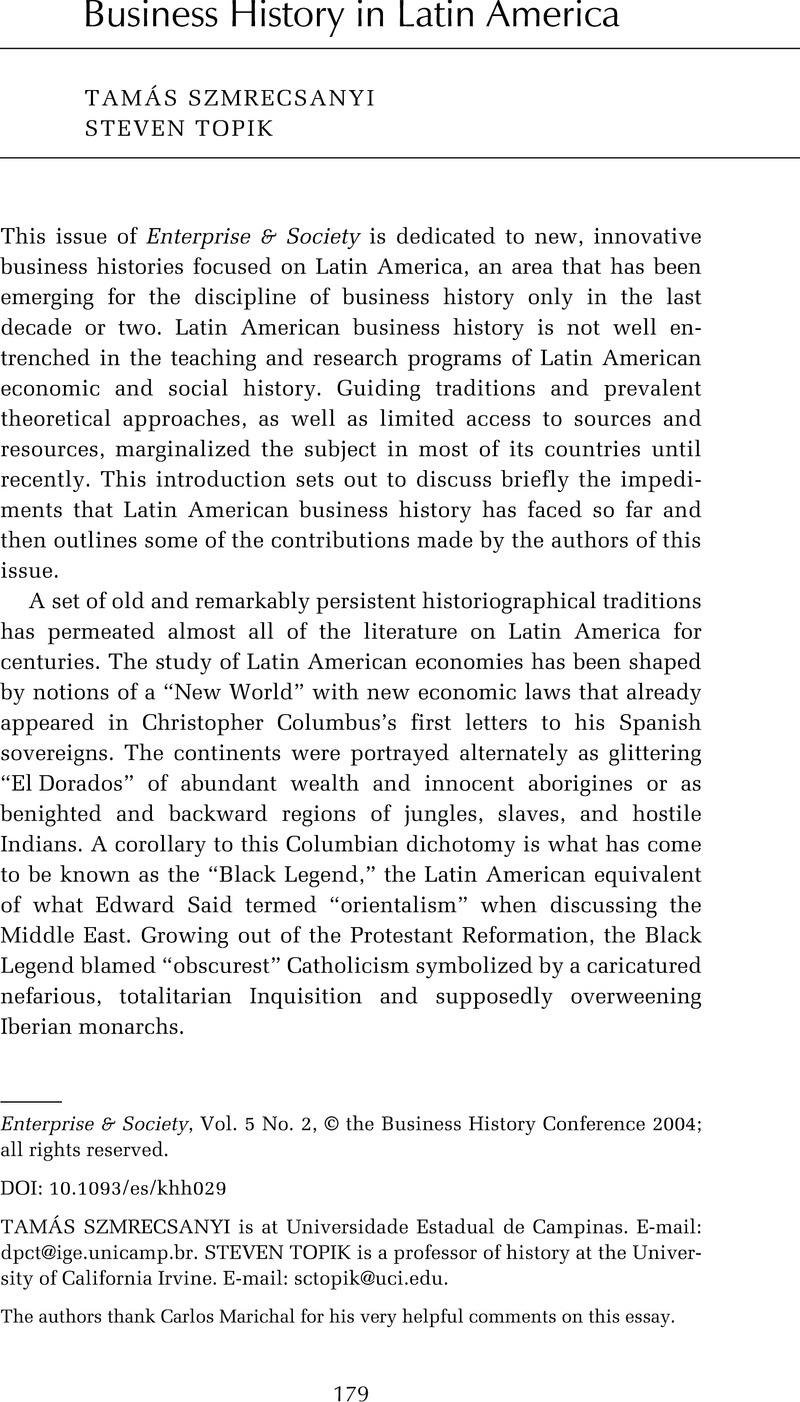Article contents
Business History in Latin America
Published online by Cambridge University Press: 18 February 2015
Abstract

- Type
- Guest Editors' Introduction
- Information
- Copyright
- Enterprise & Society, Vol. 5 No. 2, © the Business History Conference 2004; all rights reserved
References
1. Perhaps the most eloquent statement of this position is Stein, Stanley J. and Stein, Barbara H., The Colonial Heritage of Latin America: Essays on Economic Dependence in Perspective (New York, 1970).CrossRefGoogle Scholar
2. Pomeranz, Kenneth, The Great Divergence, China, Europe and the Making of the Modern World Economy (Princeton, N.J., 2000).CrossRefGoogle Scholar
3. One of the most influential statements of this position is Donghi’s, Tulio Halperín Historia contemporanea de América Latina (Madrid, 1969).Google Scholar
4. See, for instance, Business History 39 (1965). Also see Florescano, Enrique, Haciendas, latifundios, y plantaciones en América Latina (Mexico, 1975).Google Scholar
5. See Business History 59 (1985). The best and most up-to-date place to start on the business history of Latin America is Carlos Guevara, Dávila L. de and Miller, Rory, eds., Business History in Latin America: The Experience of Seven Countries (Liverpool, U.K., 1999)Google Scholar, and particularly Rory Miller’s “Business History in Latin America, an Introduction” in the volume. The book sports a 57-page bibliography on the business history of Argentina, Brazil, Chile, Colombia, Mexico, Peru, and Venezuela. Also see Sutter, Carmen Cariola et al., Latin America: A Guide to Economic History, 1830-1930 (Berkeley, Calif., 1977).Google Scholar
6. Platt, D. C. M., ed., British Imperialism 1840-1930: An Inquiry Based on British Experience in Latin America (Oxford, U.K., 1977).Google Scholar
7. For example: Klubock, Thomas, Contested Communities: Class, Gender, and Politics in Chile’s El Teniente Copper Mine, 1904-1951 (Durham, N.C., 1998)CrossRefGoogle Scholar; Moreno, Julio, Yankee Don’t Go Home: Mexican Nationalism, American Business Culture, and the Shaping of Modern Mexico, 1920-1950 (Chapel Hill, N.C., 2003)Google Scholar; and O’Brien, Thomas, The Revolutionary Mission: American Enterprise in Latin America, 1900-1945 (Cambridge, U.K., 1996).Google Scholar
8. An exception is Elisabeth von der Weid, Ana Marta Rodrigues Bastos, and Elia, Francisco Carlos, O fio da meada. estratégia de expansão de uma industria têxtil: Companhia América Fabril, 1878–1930 (Rio de Janeiro, 1986).Google Scholar
9. One thinks of, for example, CONDUMEX (Centro de Estudios de Historia de Mexico) and the Banamex archives in Mexico City, and IBMEC (Instituto Brasileiro de Mercados de Capitais) in Rio de Janeiro.
10. Goodall, Francis, Gourvish, Terry, and Tolliday, Steven, eds., International Bibliography of Business History (London, 1997).Google Scholar
11. For a discussion of the application in Latin America of social scientific theories, including the economic views of Douglass North, Alexander Gerschenkron, and Karl Polanyi, see Centeno, Miguel Angel and López-Alves, Fernando, eds., The Other Mirror: Grand Theory through the Lens of Latin America (Princeton, N.J., 2001).Google Scholar Two recent collections that exemplify the concern with the institutional history of Latin America are Coatsworth, John H. and Taylor, Alan M., Latin America and the World Economy since 1800 (Cambridge, Mass., 1998)Google Scholar; and Haber, Stephen, How Latin America Fell Behind: The Economic History of Brazil and Mexico (Stanford, Calif., 1997).Google Scholar
12. Among the exceptions we should mention some high-quality exponents like Andrés Regalsky and Maria Inés Barbero.
13. The papers of the second conference, some of which are in English, have been reissued recently in Szmrecsányi, Tamás and Maranhão, Ricardo, eds., Historia de empresas e desenvolvimento econômico: coletânea de textos apresentada na II Conferência Internacional de História de Empresas, Campus da USP, setembro de 1993 (São Paulo, 2001).Google Scholar
14. See, for example, Marichal, Carlos and Cerutti, Mario, eds., Historia de las grandes empresas en México, 1850-1930 (Mexico, 1997)Google Scholar; and Cerutti, Mario, Proprietarios, empresarios en el norte de México: Monterrey de 1848 a la globalization (Mexico, 2000).Google Scholar
- 3
- Cited by


